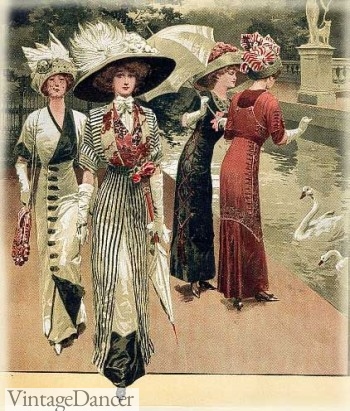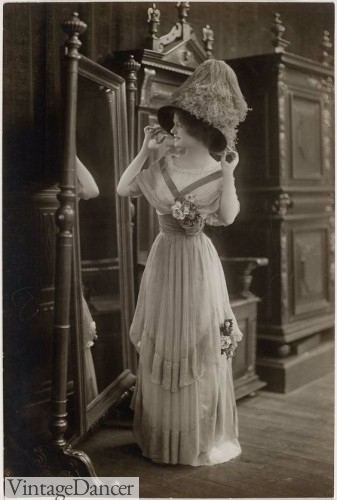Their trousers were ankle length once their cuffs were turned up. Womens fashion in 1912 and the upper class The rich arrived wearing the latest fashions.
1912 white one button coat beach suit.

. Fake vents in sleeve hems. Etiquette expert William Hanson suggests that your vocabulary can reveal your social class even though the. As a result they were often treated as children.
This guide introduces evening dress styles of the early 20th Century to aid in the design and construction of a period ensemble to wear to a. The idea behind capitalism suggested that each person works for themselves and therefore their money and status is dictated by the amount of hard work they put in. Tailcoat is accessorized with detachable lac cuffs and a matching flounced lace dickey.
On one hand the upper middle class adopted the Edwardian fashion wholeheartedly on the other the lower middle class clung to the Victorian fashion. Class and Taste in Edwardian England The class system in England during the first decade of the 20th century was divided into the upper middle and working classes. In 1912 England there were strong distinctions between the upper and lower classes and higher class citizens saw no need to change the status quo.
The fashions for second and third class passengers were simple modest and affordable yet not without influence from upper class fashions of 1912. The smock dress often worn with a pinafore which had been popular since the 1890s continued to be worn by young girls in the first part of the decade and can. Social class in Edwardian times There are three main types of social class.
These light colors were worn during leisurely pursuits such as vacationing to a beach or seaside resort picnicking taking a cruise yachting or playing summer sports such as golf tennis cricket and polo. In the 60s and 70s fashion was a largely aspirational medium. The upper middle class may have had an all-white suit.
Black wool pants with figured braid down each outer side of legs that has faded to brown. They were not allowed to vote own property or even work outside the home if they were married. In 1912 women had no rights.
Coat is single-breasted with 6 fabric covered buttons and fake buttonholes. That influence is working class culture and without it fashion would not be what it is today. Burgundy deep purple medium blue and olive green brought an optimistic spirit to a generation of people who were tiring of the old ways built on a strict class system.
Light blue green grey tan ivory and white dominated upper-class summer wardrobes. The upper class made up 5 of Britain. The Edwardian period has been named after King Edward VII who succeeded Queen Victoria in the year 1901.
English is the language of our country yet many of us use different vocabulary and colloquial slang depending on where we are and what lives we lead. For others it was a swift and. Gentlemen wore white tie consisting of a tailcoat white pique waistcoat and bow tie.
Dressing for Dinner on the Titanic. Their formal shirts were pressed into wings at the collars and they wore ascot ties for formal occasions. With the accession of King Edward on the throne the glorious Victorian age of England came to a sharp end.
C hildrens dress from 1910-1919 saw a move toward greater simplicity. Women wore fancy dresses with very tight corsets and the skirt gathered at the waist which fell over the layers of petticoats and undergarments. Men wore three piece suits with a matching waistcoat.
They were the richest and owned practically everything. If you use these words then you are upper class according to an etiquette expert. Still in 1912 there was a lot to a mans wardrobe.
These were a set of rules and laws for women. Upper class women lived their lives by following the rules of etiquette. The period of 1910-1912 sometimes called the Titanic Era or Pre War Era World War I saw the end of the Edwardian Age.
They lived in luxury and could easily afford everythingThey had a good education and were involved in lots of leisure activities such as. It was the growing middle class of which the Colemans and Waterhouses were a part that changed the most. These changes meant the lower classes could now emulate the upper class in dress --a trend that was met by some derision and criticism.
There was the upper class middle class and the working class. As the Edwardian era waned and the Art Deco era. There was the upper class middle class and the working class.
If your hair did not have a natural wave it would generally be curled through rag or. Some had boarded the ship because it was the latest thing a fun diversion and a trip to America into the bargain. For women this consisted of an evening gown no hat long white gloves kid leather or satin shoes to match the gown opera bag fan and scarf.
Middle class upper class and working class. Two buttons at each wrist. 19th Amendment passed in 1920 allowing all American Women to vote On August 19 1912 the New Orleans Picayune stated Never before in the history of the United States have women taken a deeper interest in a.
Edwardian Era Society and daily life of the Edwardians. They were short gaiters or spats for shoes. LOOK BACK AT 1912 With King George V on the throne and Herbert Henry Asquith leading Britain as Prime Minister the prevailing styles of the day comprised broad-brimmed hats tunics over long underskirts softly-defined waists and curved-heel shoes.
The changes in menswear were not as revolutionary as those in ladies fashions. Gender Roles Jobs In Society Fashion Upper Class. They were not allowed to vote and were portrayed as gentle and demure.
In the early 1910s womens hair began with thick wavy hair that was dressed in loose Grecian styles. Despite this the upper class can potentially control more wealth than all of these groups combined. The working class was so busy in the daily battle of arranging a square.
Victorian age was a period of immense conservatism and mostly gender biases. By 1912 new colors emerged for all classes. Completing the 1912 Evening Look.
Wealth The upper class are typically defined as the top one or two percent of families in terms of wealthThis makes the upper class about 2 of the population such that the bourgeois middle class and lower class are all larger groups. Clothing was designed to. In 1912 London was divided in a class system.
They probably had at least one servant and life was a lot better for them than the working class. Wavy hair was desired specifically the kind of wave that comes from thoroughly brushing out curly hair. The middle class were the people who were doing okay and worked in offices.
Black satin lining in body of coat off white silk in sleeves. The early years of the 1910s were an era of transition in fashion for women. In addition they wore elaborate trousers and waistcoats.
In 1912 London was divided in a class system. What was the class system like in the Edwardian period. Women in 1912 were treated very differently to how they are treated now.
The men liked to keep their hair short and have a pointed beard with a moustache. Patterns were popular too for day looks.

Fashion History 1912 British Vogue British Vogue

Titanic Fashion 1st Class Women S Clothing
Vintage Victorian Titanic Ladies Fashions

1912 Clothing Ascot Fashion Hats And Dresses Stock Photo Alamy

Fashion History 1912 British Vogue British Vogue
Dressing For Dinner On The Titanic Early 1910s Evening Dress Demode


0 komentar
Posting Komentar